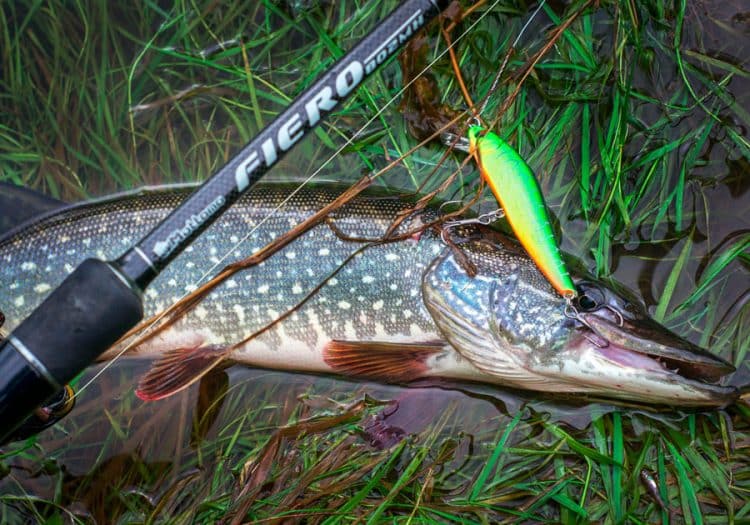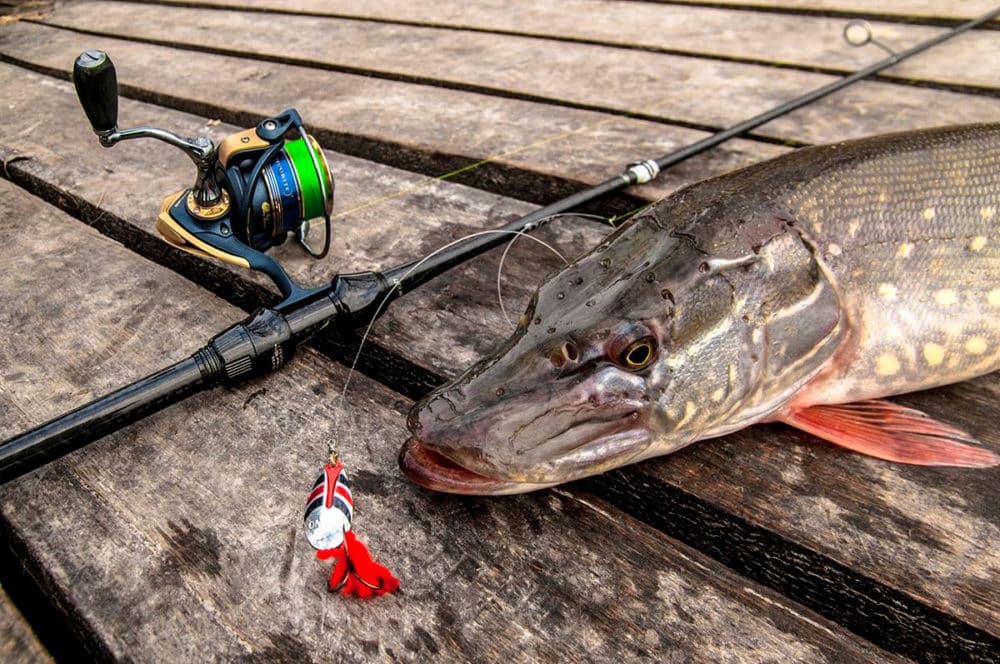Nature does not have bad weather – a well-known saying that has nothing to do with fishing. Even a novice angler knows that many factors affect the biting of fish – atmospheric pressure, rain and other types of precipitation, air and water temperature, wind strength and its direction, moon phases andseal migration season… The pike also does not always bite equally actively, – the task of the angler is to constantly analyze, observe and collect bits of information together in order to know what pressure, wind direction, and other weather factors are to the liking of the toothy, and when, as they say: “June, go fishing spit “(it is not!). https://youtu.be/0qajFFnsdXA
All the information presented is not dogma, there are no rules without exceptions. Sometimes, in the July heat, in the middle of the day, the pike rages and grabs a camera inadvertently dropped into the water, and sometimes on a cloudy day with a light drizzle, it is silent, like Gerasim over mumu.
- Correlation of weather phenomena and pike biting
- Time of day: illumination, visibility in water, biorhythms
- Optimum atmospheric pressure for pike fishing in spring, autumn and winter
- Wind strength and direction
- Precipitation – does a pike bite in drizzle, rain, downpour
- Air temperature
- Water temperature
- Moon phases
- Depending on the season – the seasonality of pike biting: a brief summary
- Nice cool pike weather in spring
- Summer time – which is to the liking of a toothy in the heat
- When pike bites best in autumn – pressure, wind and other weather factors
- Winter harvest
- Nice environment yes weather for pike – throw and pull
- Neutral environment – time to prove yourself as a professional
- It is better to stay at home with children, or do not go to visit the pike
- Putting the system together is a daunting task
- Поделиться ссылкой:
Correlation of weather phenomena and pike biting
So, experience shows that the following weather phenomena and events affect the biting of pike:
- Season . Spring Summer Autumn.
- Time of day . Morning afternoon Evening Night.
- Atmospheric pressure (low, normal, high).
- Precipitation (rain, snow, hail).
- Wind strength and direction (calm, moderate breeze, strong wind, squall).
- Air temperature .
- Water temperature .
- Moon phases (lunar pike fishing calendar).
- Water level, its transparency .
Almost all weather parameters affecting pike biting are closely tied to the season of the year, therefore, taking into account general principles, we will also make a start from the main factor – seasonality.
Time of day: illumination, visibility in water, biorhythms
In summer, pike is caught at the following times of the day in descending order:
- the morning dawn from the spruce is visible until the first rays of the sun;
- two hours after sunrise;
- evening – hours from 17 to 19;
- in the daytime – the more sunshine, the weaker the bite and vice versa;
- at night – rarely, but it happens, especially if the night is moonlit.
Such a gradation is associated with biorhythms – the predator fills its belly in the summer during those hours when the water is as cool as possible. In the sun, it is worth looking for her in the pits, although there, too, success is not guaranteed at this time – the somnambulist is resting. At night, the visibility is minimal, because the activity of the pike also decreases, it is not a nocturnal predator, not a burbot or catfish.
Optimum atmospheric pressure for pike fishing in spring, autumn and winter
Atmospheric pressure is measured in millimeters of mercury, normally 760 mm at sea level. Such pressure is considered normal, respectively, higher than this indicator – increased, lower – decreased. With increased pressure, the pike rises to the surface of the reservoir, with a decrease, it sinks to the bottom. This is due to the fact that when the pressure decreases, carbon dioxide and other harmful gases rise to the surface of the water. This is worth considering when fishing. At a reduced pressure, rain and wind are usually observed, an increase, on the contrary, is accompanied by clear and sunny weather.
Note that the main axiom is that the stability of atmospheric pressure is important, and not its qualitative value. If the pressure does not change, or changes within 3-8 mm over several days, you can safely go fishing. But the races force the fish to change their usual way of life (to change the place of stay and depth, the activity decreases due to a painful condition), due to the fact that the composition and density of the water changes.
From the experience of catching a striped predator, it can be noted that the
pike bites well at a consistently low pressure in the region of 740-750 mm . A small breeze from the west, south or south-west direction will be a plus. At high pressure (and this is heat and heat), the predator does not take, or takes only at dawn.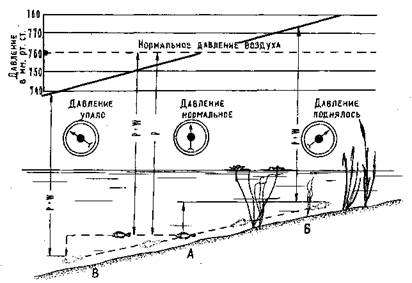
Wind strength and direction
The breeze has a positive effect on the activity of the pike. It raises ripples, this disorientates the fish and is easier to deceive, plus the wind is often accompanied by a gradual decrease in pressure, which is a plus when fishing toothed and striped. The power of the gusts can even be significant, if there are no pressure surges, this does not worsen the bite. Another point is that it is very difficult to catch in a strong flurry, especially with a spinning rod. In calm weather, the nibble is not so active, as a rule, although at dawn it’s the opposite. The best weather at morning dawn is fog or light drizzle, calm or light breeze. The best wind directions are westerly, southerly and south-westerly without a sharp change in direction.
Precipitation – does a pike bite in drizzle, rain, downpour
It has been noticed that the pike very readily responds to spinning lures in a light heavy drizzling rain, which either intensifies or stops altogether. This is especially true in the summer season – the temperature of the air and water drops, the pressure decreases. This provokes the predator to be active and hungry.
It’s important to know! Before a thunderstorm in the summer, in 2-3 hours, an instant activation of the zhora is very often observed, which, as abruptly begins, just as abruptly ends. Don’t miss this opportunity.
Air temperature
It does not have a direct effect, but it has an indirect significance. An increase in air temperature is associated with an increase in pressure and an increase in water temperature. That in the summer goes to a minus, therefore it is better to catch at dawn. In spring and autumn (Indian summer is especially typical), on the contrary, a short-term improvement in the weather can have a positive effect on the activity of the pike.
Water temperature
The pike does not tolerate extremes. Water boiling from the heat in summer, or cold to zero in winter – don’t expect pike biting. In the June-August heat, the water warms up as much as possible and at this time it is worth looking for a predator in pits, on a stream, in zones where several multidirectional currents collide and create an aerator effect – boiling water saturated with oxygen. It is also worth shifting the emphasis on fishing for pike at dawn, in rain and fog – in such weather and activity is more and bites greedily. In winter, in the wilderness, it is usually impossible to lure out a pike, but if hunting is worse than captivity, you can try to look for places where the water is warmer and saturated with oxygen – dams, bridges, hydroelectric power plants.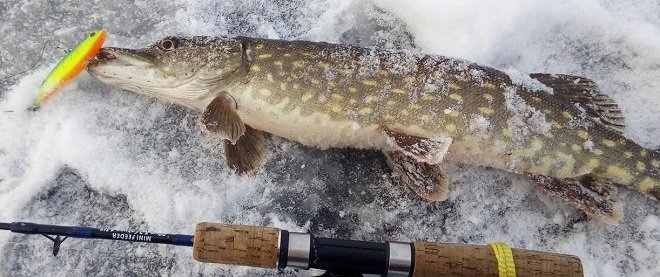
Moon phases
A very controversial factor, some anglers do not pay attention to it, and some put it at the forefront. If you believe in omens, then there is information from the aksakals of fishing skill that the pike bite better in a young month, as well as a week before and a week after. In the full moon – spit on fishing. We adhere to a more standard point of view, according to which the weather pays much more attention to pike than incomprehensible factors.
Depending on the season – the seasonality of pike biting: a brief summary
Nice cool pike weather in spring
In spring, pike begins to actively feed before spawning and after spawning in 7-10 days, usually in mid-April-early May. On reservoirs where there is no prohibition, it is worth trying to catch it with silvery bait, since the water is muddy and dirty. You can often find it in the heated areas of the reservoir – it was at this time that the heated water is a plus. Good quiet days, with a slight southerly wind. The gloomy mood of the weather is also working. Good
spoons , noisy minnow wobblers and cranks.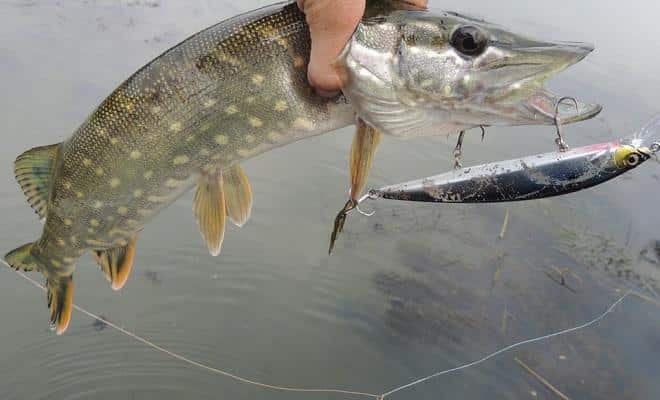
Summer time – which is to the liking of a toothy in the heat
In the heat, fishing should be transferred to the dawn – evening and especially morning. It is good when the pressure is settled around 740 mm for the middle latitudes of Russia and the CIS. If it is foggy outside, cloudy and rainy weather without a shower, or just the sky is covered with clouds, then you can catch the predator throughout the day. Lures – jig, oscillating and spinning lures, wobblers. In the very sun, we go to the pits, curbs and areas next to the fast current. We fish in the water column and at the bottom.
When pike bites best in autumn – pressure, wind and other weather factors
In early autumn – mid-August-September, the pike still lives according to the “rules” of summer time – it is active at low pressure, prone to feeding in heavy rain and a cool day. Autumn October – November, when the average daily temperature drops below 15 degrees, it is time for the pre-spawning pike to eat, which will not be missed by any self-respecting spinning fisherman. The best pressure for fishing in the fall is stable, slightly above normal or normal. It is well caught throughout the day. There are usually several bursts of activity: 7-9 am, 15-17 pm and at sunset.
Winter harvest
In winter, pike bite well on the first ice. It is especially active during light snowfall and light frost. In a blizzard and blizzard, activity is weak. In the wilderness, it is worth looking for places saturated with oxygen – dams, bridges, openings, cracks in the ice. https://youtu.be/43It3DDL2aE
Nice environment yes weather for pike – throw and pull
There are days and even weeks when even an inexperienced angler with a minimum baggage of knowledge and the simplest gear does not return home without a catch. What is the ideal spinning day – what weather is the best time to catch pike?
Situation one : Staritsa, 4-5 o’clock in the morning, light fog on the water – the water is steaming, as fishermen like to say. Not a single petal on the hanging willows will move. It’s + 18 ° C outside, a little chilly at dawn, the water cooled down a little overnight. Crucian carp rubs near the water lilies. Turntables, minnow wobblers go into battle …
Situation two: Channel pits at the feet, and a thunderstorm is brewing on the horizon, thunderclouds and formidable clouds knock one to one. Before the first drops, no more than an hour and a half. It is unbearably hot, but in a few tens of minutes everything will turn from head to foot. A jig on a cord, a trophy in my head …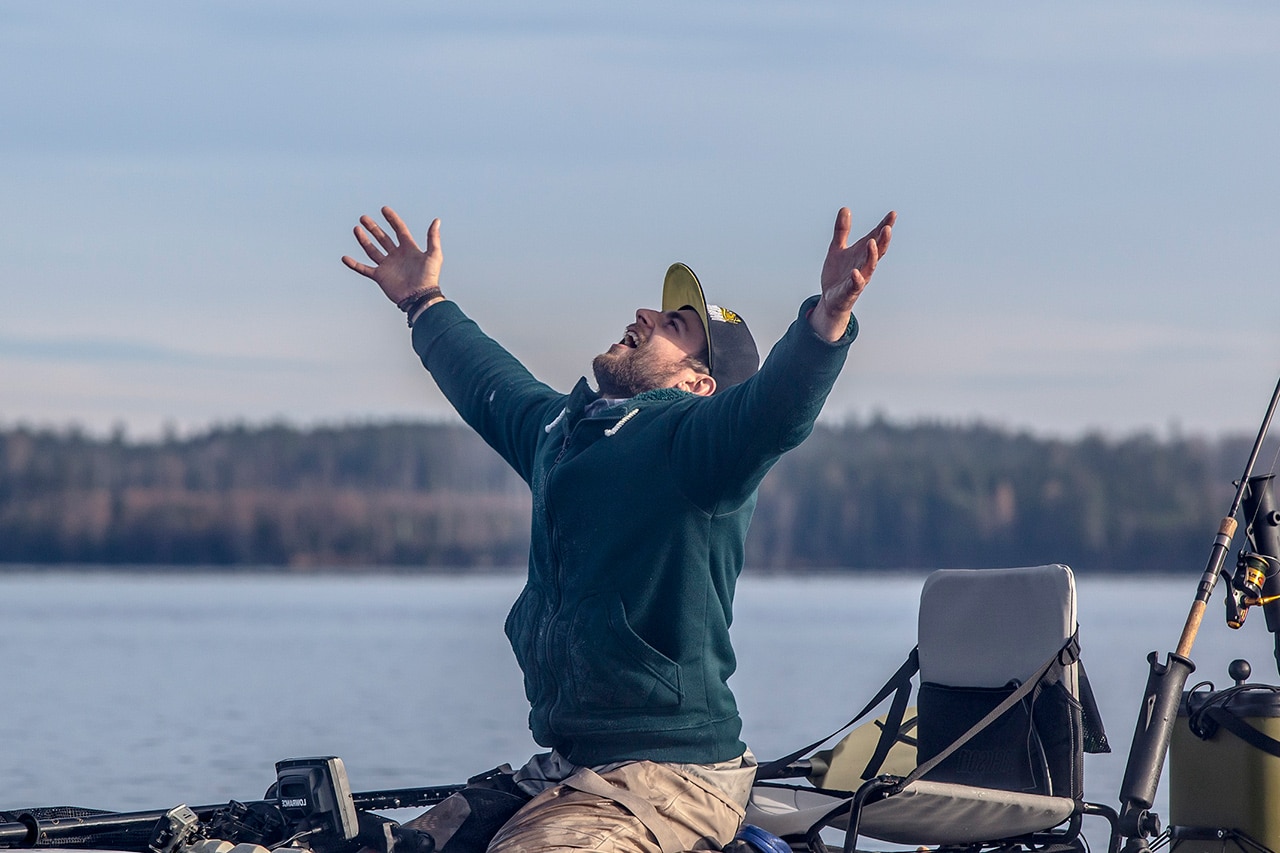
Neutral environment – time to prove yourself as a professional
It’s hot … There is no way to get into the dawn. In search of a curb, we find a pit. In hot weather in summer it is worth looking for pike in and out of it. The most lazy postings along the bottom – edible rubber, oscillators. Spring, chilly and pounding mercilessly rain, but hunting is worse than bondage. The wind is passable – east. We find a promising point and, putting on a raincoat gushing water – another cast, another cast …
It is better to stay at home with children, or do not go to visit the pike
North wind, outside plus 13, and yesterday it was 28. Gusts bend birch, like chips. Praise and honor to madness, but fishing in such weather will not bring pleasure and catch in most cases.
Putting the system together is a daunting task
In general, it is worth noting that fish bite where we are not and when we are not. Or, as my father used to say, fish bite especially well on weekends – on weekdays they don’t let go of work. That is, you can and should pay attention to the weather – the analysis of the influence of pressure, rain and temperature on the bite of pike is useful and interesting, but you do not need to get hung up, but it is worth catching for your own pleasure.


